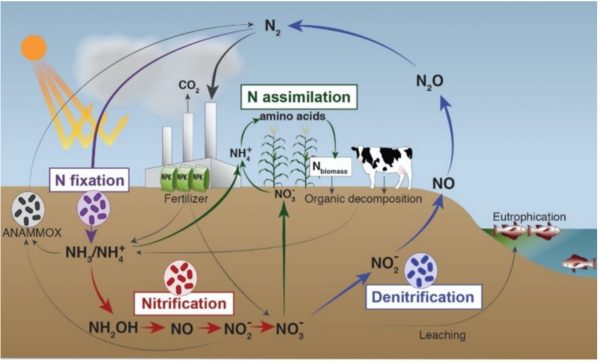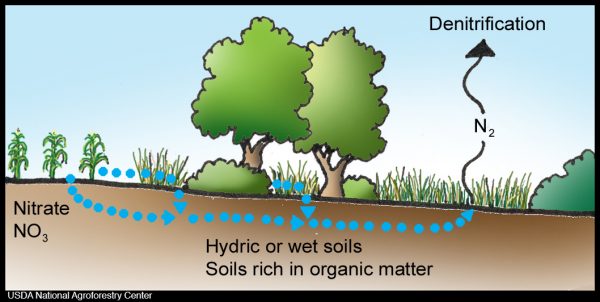For her capstone project, graduating environmental resource management student Bryn Wambaugh investigated the work being done in the Shaver’s Creek watershed by the Shale Hills Critical Zone Observatory. We are sharing a series of Bryn’s articles, written with the public in mind, to educate readers while illustrating the great research done at the Shale Hills CZO and supported by Shaver’s Creek.
Read the previous entry in Bryn’s series:
What Is Nutrient Pollution and What Are Its Impacts?
Riparian forest buffers (riparian buffers) are areas next to streams, lakes, or wetlands that are made up of trees, shrubs, and other perennial plants and provide a “buffer zone” between agricultural land and waterways (USDA). Riparian buffers have many conservation benefits, including increasing denitrification, diluting chemicals found in fertilizers, and stabilizing streambanks. Landowners have access to state and federal government grants to fund the planting and upkeep of buffers. I will also briefly go over some of the other added benefits of riparian buffers.

Only 30–50% of the ammonia and nitrate in our fertilizers is taken up by plants (Lehnert, 2016). This means the rest of these nutrients runs off and causes detrimental environmental effects. Denitrification is the process in which soil microbes convert nitrate to nitrogen gas. Denitrification is associated with the presence of organic carbon. Organic carbon acts as an electron donor and “feeds” the denitrifying microbes (Spruill, 2000). Riparian buffers increase the amount of dissolved organic carbon (DOC) in the soil, thus decreasing the amount of nitrate in shallow groundwater before it even reaches streams. Spruill (2000) found that nitrate was 95% lower in buffer areas compared to non-buffer areas.

Riparian buffers link aquatic and terrestrial ecosystems and influence both. Riparian buffers can dilute, modify, or incorporate substances before they enter stream habitats (Osborne and Kovacic, 1993). Lower concentrations of chloride and nitrate in surface water indicate that dilution plays just as important of a role in removing nitrate from shallow groundwater as denitrification does (Spruill, 2000). Riparian buffers prevent streambank erosion in small streams. Vegetation with deep, fibrous roots within 25 feet of a stream prevents erosion. The roots help anchor the soil and prevent it from easily washing away. Vegetation on streambanks also helps to reduce the velocity and erosive forces of water (Beddoes et al., 2007).
Resource Enhancement and Protection Program (REAP) provides farmers, landowners, and businesses an opportunity to earn tax credits for “implementing Best Management Practices (BMPs) that will enhance farm production and protect natural resources” (Resource Enhancement & Protection, 2021). Your local Conservation District is willing to help fill out any paperwork you need to apply for REAP and any other government program landowners are interested in. Every county in PA except Philadelphia County has a Conservation District.
Riparian buffers effectively reduce nitrate through denitrification, dilute chemicals, and stabilize streambanks. The PA DEP offers programs for farmers, landowners, and businesses who want to install riparian buffers.
References
- Beddoes, J., Hoag, J. C., Sampson, R., & Ogle, D. (2007, June). Riparian Buffer Design and Species Consideration. USDA NRCS.
- Lehnert, N. (2016). The Nitrogen Cycle. Retrieved May 05, 2021, from http://www.umich.edu/~lehnert/Ncycle.html
- OSBORNE, L. L., & KOVACIC, D. A. (1993). Riparian vegetated buffer strips in water-quality restoration and stream management. Freshwater Biology, 29(2), 243-258. doi:10.1111/j.1365-2427.1993.tb00761.x
- Resource enhancement & protection. Retrieved May 05, 2021, from https://www.agriculture.pa.gov/Plants_Land_Water/StateConservationCommission/REAP/Pages/default.aspx
- Riparian forest Buffers. Retrieved May 05, 2021, from https://www.fs.usda.gov/nac/practices/riparian-forest-buffers.php
- Spruill, T. B. (2000). Statistical evaluation of effects of riparian buffers on nitrate and ground water quality. Journal of Environmental Quality, 29(5), 1523-1538. https://doi.org/10.2134/jeq2000.00472425002900050020x
